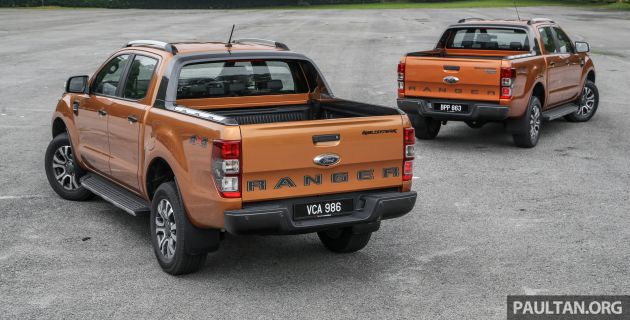The Ford Ranger T6 may be a good six years old now, but the Blue Oval pick-up truck is still going strong. Having received its first facelift in late 2015, it’s now undergone a second nip and tuck, and while the new model looks relatively identical, it hides a raft of updates under the skin. How better, then, to elucidate the various changes than with a good ol’ new versus old gallery?
Well, we’ve put the new Ranger in range-topping (for now, before the Raptor comes in) Wildtrak 4×4 form, side-by-side with the equivalent variant from 2016. As you can see, the aesthetic revisions are relatively minor, with a new twin-louvre grille and a downturned central air intake at the front being the most prominent.
As befits the Wildtrak, both cars get a larger grille, a silver underguard, roof rails and an integrated sports bar with built-in LED bed lighting, but the new one also gets larger fog light surrounds. The new truck continues to get dark grey highlights around the grille, wing mirrors and door handles.
Meanwhile, the 18-inch alloy wheels are of the same design as before, but they can now be found on the XLT+ (without the two-tone finish) as well. Both cars wear orange hero colours, although the previous model gets Pride Orange and the new one is painted in the lighter Saber.
Look closely and you’ll find a few more detail changes. The headlights, which were halogen projectors on the XLT and Wildtrak, are now xenons on the XLT+ and Wildtrak, with LED daytime running lights offered on the XLT and up. The new Wildtrak also features LED fog lights, while keyless entry and push-button start finally make their way to the Ranger on the XLT+ and Wildtrak, as do an easy-lift tailgate.
The interior of the WildTrak again features few changes, limited to an all-black colour scheme (versus the old grey lower dashboard), gloss grey decorative trim, full leather seats (the old model had orange fabric centres) and new gearshift buttons on the gearknob. There’s also active noise cancellation on the 4×4.

You still get a soft-touch upper dash with real orange stitching as well as the SYNC 3 infotainment system with an eight-inch touchscreen and Apple CarPlay and Android Auto connectivity. SYNC 3 was introduced on the Wildtrak in late 2016, and has now found its way to the XLT+ as well. One big change is that the latest dash design has been carried over to the base XL, which had hitherto used the same unit since 2012.
It’s under the bonnet where you’ll find the biggest differences between old and new. The XL and XLT models still get a 2.2 litre Puma four-cylinder turbodiesel, but the high-output variable geometry turbo (VGT) version has been standardised across the two models, making 160 PS and 385 Nm of torque instead of the 125 PS and 370 Nm in the old XL variant. This is paired to six-speed manual and automatic gearboxes.
While the old 2.2 litre mill remains, the 3.2 litre five-cylinder variant has been thoroughly kicked to the kerb. Replacing it is a new 2.0 litre EcoBlue unit from the Panther family, available in two variants – the XLT+ and the Wildtrak 4×2 get a single-turbo (Si-Turbo) version producing 180 PS and 420 Nm.

The one you’ll want is the twin-turbo (Bi-Turbo) unit in this Wildtrak 4×4, churning out 213 PS and 500 Nm – yes, the same output figures as the Raptor. Both the 2.0 litre engines are paired to a Getrag 10-speed automatic transmission, with the XLT+ and the Wildtrak 4×4 receiving four-wheel drive.
Safety is another area where the new Ranger has taken great strides. The previous Wildtrak was the first pick-up truck to come with forward collision warning, adaptive cruise control and lane keeping assist, but the new 4×4 version goes one better with autonomous emergency braking and parking assist. The 4×2 continues to get six airbags and stability control, but does away without the driver assistance systems.
Pricing of the new 2019 Ford Ranger starts at RM90,888 for the 2.2L XL Single Cab manual and tops out at RM144,888 for this Wildtrak 4×4. You can check out our full spec-by-spec comparison here, and watch our men Hafriz and Matthew explain the changes visually in the video above.
Source: Read Full Article



